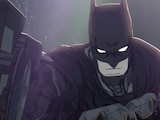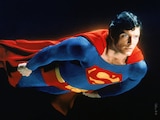What’s unique about Batman, in comparison to other superheroes, is his relationship to fear. The Batman persona itself was born out of Bruce Wayne’s fear of bats. In this sense, it’s not a surprise that so many of the Dark Knight’s biggest villains—the Joker, Scarecrow, Clayface, Two-Face—have been reimagined with a horror bent to them. To embody Batman is to embody one’s own fears. But what happens when Batman goes evil? What does this focus on fear shift into when Batman abandons his morals?
Suicide Squad: Kill the Justice League explores this question in terrifying detail. Rocksteady’s latest game is set in Metropolis in the midst of an invasion by the alien villain Brainiac, who has brainwashed members of the Justice League to do his evil bidding. This leaves a newly-formed Suicide Squad—Captain Boomerang, King Shark, Deadshot and Harley Quinn—the only ones left to stop them.

Suicide Squad: Kill the Justice League’s evil Batman is a compelling, if chilling, dark mirror to the Caped Crusader’s values, antics and comic book history. In one sequence early on in the game, dubbed “The Batman Experience,” the Squad is trapped in the Metropolis History Museum with all the lights turned off. As we navigate our way through the dark exhibit with just a flashlight at our disposal, Batman runs around in the shadows, leaving a trail of dead police officers in his wake. It’s a sequence that feels right at home with the Joker’s entrance in the “Death of the Family” story arc, from Scott Snyder and Greg Capullo’s Batman #13. During a power outage, the Joker kills an entire precinct full of GCPD officers while Jim Gordon can only helplessly beam his flashlight around.
In this sequence in the game, Batman effectively becomes the mirror image of one of his greatest foes. It’s an unexpected way of establishing an evil Batman personality that works much better than going for the easier, shallower approach, like giving Bats a machine gun. Instead, the Dark Knight becomes a villain when his actions and methods are indistinguishable from those of his enemies. For anyone (like me) who has been invested in Batman’s adventures for years, this sequence invites solemn reflection about what is so heroic about Batman in the first place.

In this sense, Suicide Squad: Kill the Justice League reveals the thin line that separates Batman from the scares that we have come to expect from his stories. The fact that it is Batman himself responsible for the carnage makes it even more impactful. At least in Batman #13, Gordon’s nightmare ends with the power coming back on and Batman standing over him, saying, “Jim, it’s me!” In Kill the Justice League, our nightmare only ends once we fight the Dark Knight himself. We no longer have the security blanket that Batman’s existence provides.
This aspect is one of the central throughlines within Kill the Justice League, piggybacking off of players’ rapport with Batman that’s been built across the Arkham games. While most of the Justice League ends up brainwashed by Brainiac, it’s Batman’s fate we see the most evidence of. Every so often, we come across bodies littered with Batarangs, or strung from the ceiling. The schematics of Batman’s heroism, his gadgets and his methodology, become warped into scenes of horror. This choice to highlight Batman’s violence specifically works because it exposes a truth we never want to consider with Batman: that his single-minded, thorough approach to fighting his enemies may be something to feared, not admired.

Ultimately, this is one of the most satisfying parts about Suicide Squad: Kill the Justice League for me. Admittedly, I went into this game conflicted because I adore Superman and John Stewart’s Green Lantern, and absolutely would not choose to kill either of them. (Ultraman and Power Ring from the Crime Syndicate though? Fair game.) But having the Justice League go bad gives us an opportunity to reflect on what makes them heroic to begin with. Batman’s case shows how the opposite of being heroic is to be feared.
And where does that leave us with the ragtag group of former Arkham inmates at the very center of Suicide Squad: Kill the Justice League? King Shark may be a little scary, just because he’s the only Squad member who could just eat someone at a moment’s notice. But Harley Quinn, Captain Boomerang and Deadshot? All flawed, slightly dysfunctional people just trying their best. If anything, seeing Batman turn evil tells us more about who we deem to be “villains” in the first place.
Suicide Squad: Kill the Justice League is now available on PS5, Xbox Series X|S and PC.
Jules Chin Greene writes about comics for DC.com, and his work can also be found at Nerdist, Popverse and Multiverse of Color. You can follow him on Twitter and Bluesky at @JulesChinGreene.
NOTE: The views and opinions expressed in this feature are solely those of Jules Chin Greene and do not necessarily reflect those of DC or Warner Bros. Discovery, nor should they be read as confirmation or denial of future DC plans.




















